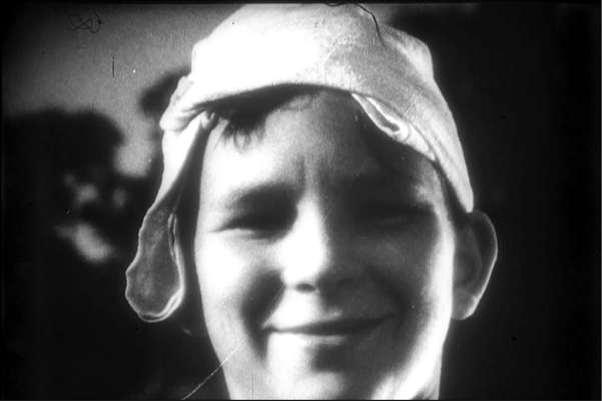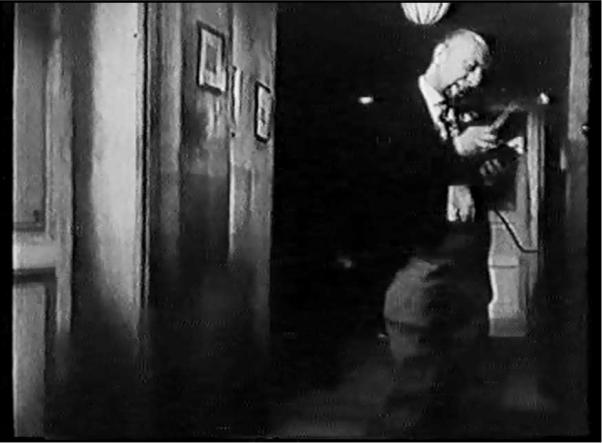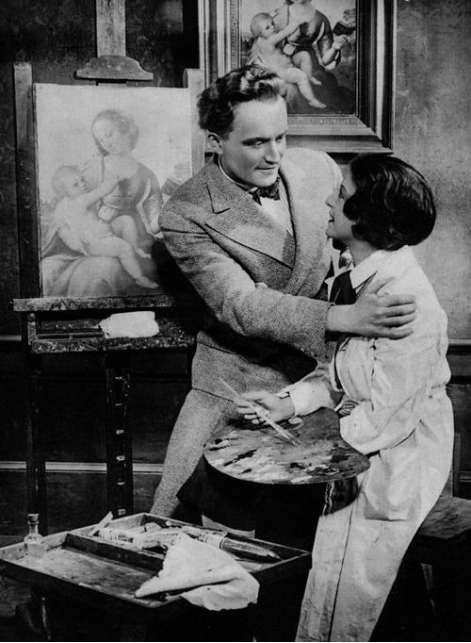
WilliamsT
.pdfdescribed the sequences in which Schüfftan's technique was employed, noting that, ‘we see the images emerging in the unconscious of a young woman on an operating-table,’ and that Schüfftan created ‘an entire flash-back sequence contained in a drop of water.’
Silence and sound: Menschen am Sonntag and Abschied
1929 saw Schüfftan's first role as cinematographer, in the film Menschen am Sonntag/People on Sunday (Siodmak, 1930), which was in production in Germany from July to December of 1929, and released in the following year. The film was created through the collaboration of a number of important voices at the very beginning of their careers, who would all move on to impact Hollywood in various forms in later years: Curt Siodmak, Robert Siodmak, Billy Wilder, Fred Zinnemann, Edgar G. Ulmer, as well as Schüfftan. Whilst the film is commonly seen as a collaborative effort between these artists, Curt Siodmak has awarded particular credit to the work of Schüfftan and Robert Siodmak, noting that ‘only Robert and the cameraman Eugen Schüfftan were responsible for its completion.’ (Siodmak in: Fisher, 1991: 251) Siodmak (Fisher, 1991: 252) elaborates on this point, stating that ‘Robert and Schüfftan did what the French and Italians did thirty years later and called the “nouvelle vague,” or the
– New Wave. Robert and Schüfftan never got the credit. They did all that years before the New Wave.’ Fred Zinnemann (1992: 14-16) has similarly highlighted the importance of Schüfftan’s role, crediting himself with little more than acting as Schüfftan’s assistant.
Menschen am Sonntag stands as an unusual example of German film production during this period for a number of reasons. For one, the film was an entirely independent production shot for small funds secured from Heinrich Nebenzahl, the founder of Nero Film, and the maternal uncle to the Siodmak brothers. It was therefore beyond the control of the Ufa studio, which heavily dominated all film output in Germany at the time. Furthermore, as Curt
61
Siodmak's words suggest, the film proved stylistically innovative in many respects, even at a time when Ufa's forays into new sound technologies were leaving the meager production values of Menschen am Sonntag far behind. As Thomas Elsaesser (2000: 433) explains, ‘Menschen am Sonntag and Abschied [similarly with direction by Robert Siodmak and cinematography by Eugen Schüfftan, made shortly after Menschen am Sonntag in 1930], which have little trace of expressionist lighting, function according to a quite different – if not diametrically opposed – aesthetic to both Expressionism and the Kammerspielfilm,’ which were the two dominant stylistic trends in the German industry at the time.
Menschen am Sonntag employed a level of realism uncommon in the time of the studiobound super-productions made by Ufa. Schüfftan’s realist approach during the Weimar period is far removed from the ‘Culture of Light’ (as her book is titled) described by Frances Guerin (2005). Guerin’s (2005: xv) valuable contribution to the use of light in Weimar cinema finds that electrified light is used ‘to represent the transformation to a modern life fashioned by technological advance in 1920s Germany.’ She adds, ‘The films use light and lighting to envision the transformation of space, conceptions of time and history, modes of representation, and the pivotal role played by industrial entertainment in their midst.’ (Ibid.) Whilst very much a story of modern life in Germany, Menschen am Sonntag removes its young protagonists from the technological Modernity of Berlin, to rural location away from the Metropolis. The film sought to capture the everyday experiences of young Berliners, by tracing their activities on a care-free Sunday. The scenario is non-descript, avoiding the complex plot maneuvers of standardized narrative cinema, and sees two young men and two young women leave Berlin to spend their day-off together on the Nikolassee beach. It is not only the scenario which sought to provide a more realistic portrait of Berlin life. A number of stylistic choices similarly subvert the dominant studio modes of production. For example, the film stars only non-professional actors, and was filmed almost in its entirety on location.
62
Furthermore, production took place only on Sundays when the actors were not otherwise engaged at work. The filmmakers were keen to point out such facts to the audience. The subtitle of the film is, ‘A film without actors’, and the opening credits feature an intertitle which explains to the spectator that, ‘These five people appeared before a camera for the first time in their lives. Today they are all back in their own jobs.’
The subtitle demonstrates the approaches made to realism within the film, but also highlights another important facet of the film: the filmmakers' combination of ‘narrative, documentary, and avant-garde techniques to foreground the epistemological status of filmic reality as a construction’ (Hake, 2008: 41). The aspects of realism sometimes function to reinforce this foregrounding of cinema's constructed nature, and at other times is at odds with it, forming a complex engagement with how narrative film itself ought to be constructed. In one particular scene which emphasizes this, the hand of the cinematographer is clearly at play. The scene occurs on location at Nikolassee beach, when the holiday makers are captured enjoying their Sunday by the beach photographer. The filmic camera occupies the point of view of the still photography camera, viewing each character in turn in close-up as they gaze into the camera's lens. When each photo is taken, there is a freeze frame, representing the still photograph, and the exposure of the camera is adjusted to allow more light into the image, reducing the detail of the subjects' faces. Then after a short moment, movement returns to the image and the exposure returns to its previous level. By adjusting the exposure in this manner, for a 'shot within a shot', Schüfftan points toward the construction of cinematic representation, and the mediating effect of the camera to glamourize a subject in the resultant image. So despite being close-ups, the real interest of these images lies in the use of the camera, rather than the subject. Curt Siodmak has made the same point when celebrating the cinematographer’s role in Menschen am Sonntag, as part of a documentary celebrating the restoration of the film in 1997 (Weekend am Wannsee, Koll, 2000): ‘along comes the great miracle known as Eugen
63

Schüfftan. Schüfftan showed what could be done with a camera. The film was about the camera, not the actors.’
Figure 8: Menschen am Sonntag: A snapshot of a Sunday Afternoon.
The innovations pursued in this film ensured that the filmmakers involved were recognized for their achievements by Ufa and the other studios, and for Schüfftan propelled him into a career as cinematographer. The liberties Schüfftan enjoyed on Menschen am Sonntag were not ones he was soon able to relive, however, and as he explained in a correspondence to the film theorist Siegfried Kracauer, dated 28th February 1943, he failed to ascribe any great importance to his subsequent work in Germany during the 1930s, feeling himself to be little more than a cog in the mechanism of the German film industry (Schüfftan, 2003: 110).
In spite of these comments by Schüfftan, his second film as cinematographer,
Abschied/Farewell (Robert Siodmak, 1930), bore heavily the influences of Menschen am
64
Sonntag. The film saw Schüfftan reunited with Robert Siodmak, as director of Abschied, although on this occasion the film was produced under the auspices of the Ufa film studio. Made from a script by Emeric Pressburger, Abschied, like Menschen am Sonntag before it, set out to recreate the realities of life in Berlin, albeit this time the realities of life in a Berlin boarding-house. In fact, the film is set entirely within the confines of the boarding-house, following Hella as she experiences a number of encounters with the male residents, before finally settling for Peter Winkler, a vacuum-cleaner salesman.
Abschied was Schüfftan's first experience of working as a cinematographer upon a sound production, which proved to be an important factor in the recreation of reality for Siodmak, who as Phillips (2004: 66) explains, found that, ‘the technical and aesthetic potential of “real cinema” similarly meant a conflation of the medium of sound film with the details of “real life”.’ However, despite the possibilities offered by sound, the technology had a marked impact upon the cinematographer. Cameras now lost their freedom of movement because they had to be loaded into glass booths to reduce the impact of the noise produced by the heavy technology. This seriously affected the concept of realism, as Petrie (1996: 21) has noted. Furthermore, Petrie (1996: 23) explains how sound technologies even affected the ability of the cinematographer to light the film: ‘Traditional arc lamps were too noisy, and were replaced by tungsten incandescent units. These lights weren't as bright, meaning a greater number needed to be used. However, this made the studio unbearably hot, and so the cinematographer was forced to shoot with less light and a much wider lens aperture.’
Indeed, thinking of Abschied alongside Menschen am Sonntag, which both purport to represent a form of reality but are divided by the boundary of sound, it is easy to see how the cinematographer’s task was heavily disrupted, causing Abschied, despite Siodmak's experiments with sound, to convey far less of a recreation of real life than Menschen am
65
Sonntag. The lighting techniques fail to appropriate the levels of realism to which the film aspires. There is a notable attempt made, through the use of on-screen light sources, such as lamps, and most commonly the light emanating through the frosted glass of the doors, however, the sources fail to be the key source of light in the film. The impact of sound is obvious, for it appears there are notably fewer lights employed than would be desired, with a spotlight favoured to light the principle actors of a scene. This tends to result in large portions of the set remaining unlit, with the actors being the subject of the spotlight. Without a use of backlights, the result is that the actors often merge with the background darkness of the set, which creates a flattening of the image, rather than a sensation of depth to which the cinematographer usually aspires. When set walls are strongly lit in the film, this tends to be because the actors are positioned close to the wall, and so they may use a shared light source, which therefore enforces realism.
66

Figure 9: Abschied. A character blends into the darkness of the background as Schüfftan struggles to overcome limitations imposed by new sound technology.
Schüfftan’s lighting does attempt in places to appropriate realism, however, compared with
Menschen am Sonntag, it is clearly the limitations of sound technology which have affected his work. Menschen am Sonntag was filmed almost entirely on location outdoors, whereas on Abschied, sound technology forced film production to remain in the studio, a fact in itself which detracts from realism. Another technique, that of deep focus, is attempted by Siodmak and Schüfftan to approach realism, but is similarly hampered by technology. On numerous occasions Siodmak places an object from the boarding-house set before the camera, shooting past this to the action beyond. This creates a sensation of the camera being hidden from the subjects, aspiring towards a deep-focus technique that Gregg Toland would achieve a number of years later on Citizen Kane (Orson Welles, 1941). However, the technology was not yet in
67
place to achieve this, and Schufftan was forced to shoot the object at the fore of the frame out of focus so that the action in the rear of the frame would be clear to the spectator.
Beyond the sound barrier
Following his work on Abschied, Schüfftan was employed as cinematographer on another
Ufa production, Das gestohlene Gesicht/The Stolen Face (Philipp Lothar Mayring and Erich Schmidt, 1930), sharing the role with Werner Bohne. The film, the feature debut for its two directors Philipp Lothar Mayring and Erich Schmidt, is a detective story surrounding the theft of a famous painting from a gallery, which is confused throughout the narrative with a copy which has been innocently produced by an art student. This is not the only case of mistaken identity in the film, which also sees the identity of the police detective in charge of the investigation stolen in attempts to recover the painting.
Considering the film had only been made shortly after Abschied, the issues raised for the cinematographer by new sound technologies seem to have been quickly adapted to. The film opens with a lively montage set in a club, in which we see the waiters performing various outlandish tricks and a female cabaret routine, all constructed through a fast pace of editing and liberal camera movements, something which was not possible only months earlier. Lighting techniques had also seen improvement since Abschied under the dominance of sound. Far less contrast, and more standard lighting techniques are employed, such as key, side and filler lights, and a strong use of back lighting to give a sense of depth. Accent lights are also used to augment the mise-en-scène, for example, to illuminate the tables in the club. Accent lights are also powerfully used in the gallery which holds the famous painting, highlighting art hanging on the walls, a sculpture, and lighting the floor of the gallery to emphasize the depth of its space.
68

Figure 10: A publicity image for Das Gestohlene Gesicht.
One particularly interesting lighting effect produced by Schüfftan occurs towards the end of the film, once the imposter of the detective has unmasked himself. He stands before a doorway, staring through the glass next to the frame, the full realization of his circumstances clearly weighing on his mind. He is filmed from the other side of the glass, looking beyond
69

the camera. His face has been lit by Schüfftan with a strong sidelight. This results in the casting of a small but distinct shadow of his profile on the door frame, highlighting his dual roles throughout the film, which have brought him to this outcome.9
The year of 1931 also saw Schüfftan turn his hand to directing on two occasions, enhancing the reputation he was already garnering through his brief experience as cinematographer. The first of these directorial credits is the film Ins Blaue hinein/Into the Blue, upon which Laszlo Schäffer performed camera duties. The film, a short comedy, is the story of a company director, his two assistants and the younger assistant's girlfriend, who abandon the failing business when it begins to struggle financially, opting instead to move in with Fritz, one of the employees, and a dog the group nearly hit as they flee. The group chooses to start a new business, grooming dogs, inspired by their canine acquaintance. When this also begins to struggle, the group gets the financial assistance it needs by claiming the reward for a missing dog.
Ins Blaue hinein had been thought lost, however it was recently discovered inside a film can donated to the French film archives of the Centre national de la cinématographie, by a collector in Holland. I was fortunate enough to view the newly discovered film at the
Deutsche Kinemathek, Berlin, in August 2009, over a year before it finally premiered on 21 November 2010, as the opening film of an exhibition held by the Museum of Moving Art, New York. The exhibition, Weimar Cinema, 1919-1933: Daydreams and Nightmares, sought to dispel the perceived dominance of Expressionism in this period, to give a more comprehensive view of the wider output of German cinema during the Weimar years. For exhibition organizer Laurence Kardish, Ins Blaue hinein proved a perfect example of the many films produced in Germany besides Expressionism. ‘It captures,’ he notes, ‘the free-
9 I am unable to illustrate this scene with an image as I have only been able to study the film at the
Deutsche Kinemathek, Berlin.
70
